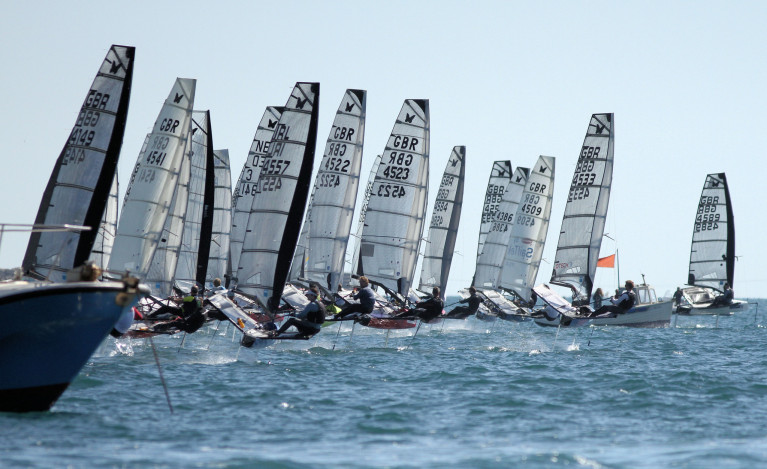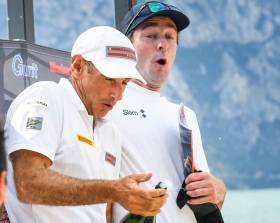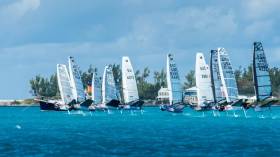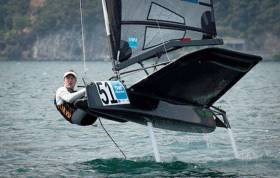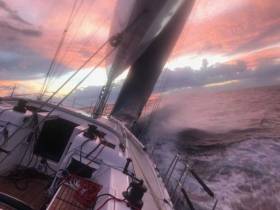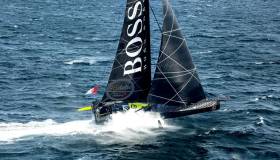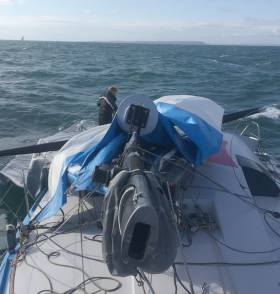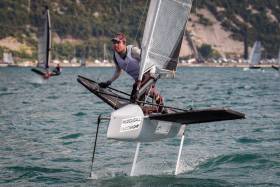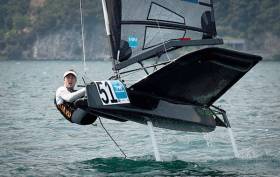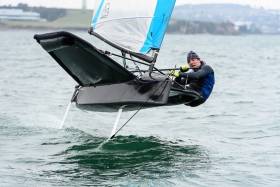Displaying items by tag: David Kenefick
The 2020 International Moth World Championships scheduled for The UK's Weymouth and Portland National Sailing Academy has been cancelled due to COVID-19.
The Organising Committee felt that the chances of being able to hold a Worlds event in September with all countries being able to participate were 'slim at best' due to the pandemic.
Leading Irish Moth sailor David Kenefick, one of a number of Irish foiling sailors who was expected to compete off the Dorset coast, has said that it was the right thing to do in the circumstances. However, the Royal Cork ace has also given a thumbs up on social media to the organisers decision to go ahead with a UK Nationals instead on the same dates, 1-11 September.
The recast event comes with an open invitation to sailors from any nation to come and race if they can make it to the UK.
Royal Cork Yacht Club's David Kenefick has more than got the upper hand on these latest foiling techniques and chalked up another significant result at International Foiling Week on Lake Garda at the weekend.
Regular Afloat readers will recall that the former Figaro solo sailor who switched to the International Moth dinghy in 2016 was a creditable 11th at the Moth Worlds in Bermuda a year ago.
Now the Cork Harbour sailor has posted a third from 83 at the biggest European Moth event at his favourite Italian venue.
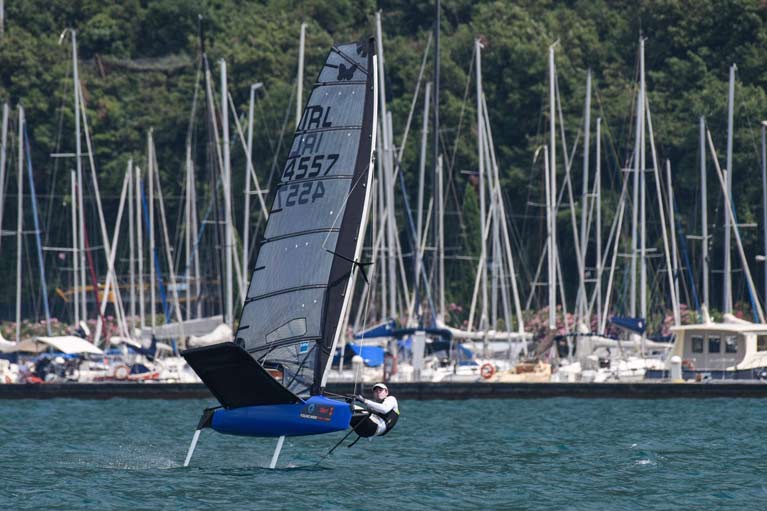 Kenefick in perfect balance at Foiling Week on Lake Garda. Photo: Martina Orsini
Kenefick in perfect balance at Foiling Week on Lake Garda. Photo: Martina Orsini
Kenefick will be back on Irish waters next month for the Irish nationals at Baltimore, West Cork from the 9-11 August.
Other Irish in Lake Garda included Alistair Kissane, from Howth Yacht Club, who took an impressive eighth overall. Kenefick's clubmate, Cian Byrne was 23rd. Ireland's Fionn Conway sailing 'Paddy' from the Dubai Offshore Sailing Club was 33rd.
Results are here
Royal Cork Yacht Club's David Kenefick has finished seventh in a fleet of 33 at the Moth Bermuda National Championship in Hamilton, Bermuda. The top result comes as the Moth World Championships begin today at the same venue.
Joshua Greenslade won the Bacardi Moth National Championship in a series that racing for the championship was cancelled yesterday due to very strong winds, so Greenslade won based on yesterday's results. Greenslade finished 1 point ahead of James Doughty while Benn Smith, the youngest competitor in the fleet at 18 years of age, was 11 points further back.
"It's a strange win, considering we only had three races, but it was fun," said the 27-year-old Greenslade who's a director of the Endeavour Community Sailing Program, a legacy of the America's Cup Endeavour program. Previously, Greenslade won national championships in the Optimist Class, 420 Class and match racing.
Racing was cancelled because the wind on Great Sound was blowing a steady 25 knots with gusts approaching 40 knots. As Afloat.ie reported previously, the Moth World Championship is scheduled to begin today with Kenefick and Dubliner Rory Fitzpatrick in action.
British sailor Paul Goodison, the favorite to win his third consecutive Moth world championship, won the regatta overall with the low score of 3 points. Another British sailor, Ben Paton, placed second and Matthew Chew of Australia was third. The Bermuda Nationals was an open regatta but the title of Bermuda National Champion could only be awarded to a Bermudian.
Bacardi Bermuda Moth National Championship Top Five Final Standings
(After 3 races)
1. Paul Goodison (U.K.) 1-1-1 - 3 points
2. Ben Paton (U.K.) 2-2-6 - 10
3. Matthew Chew (AUS) 6-5-3 - 14
4. Rome Kirby (USA) 3-3-10 - 16
5. Simon Hiscocks (U.K.) 7-8-2 - 17
Full results are here
An international fleet featuring two Irish foilers plus the reigning two-time world champion Paul Goodison of the U.K. is set to contend the Bacardi Moth World Championship next week on Bermuda's Great Sound.
Royal Cork's David Kenefick and Rory Fitzpatrick from the National Yacht Club and Royal Irish Yacht Club will contest the event hosted by the Royal Bermuda Yacht Club and co-organised with the International Moth Class Association.
Laset year, Kenefick was the top Irish performer at a bumper edition of the foiling event in Italy when the Cork Harbour man finished 31st.
The 77th running of the Moth Worlds is scheduled Mar. 26-Apr. 1. Prior to that the Bermuda Moth National Championship will be staged Mar. 23-24.
Goodison, a member of the Artemis Racing Team for the America's Cup last summer in Bermuda, won the Worlds last year in Italy and two years ago in Japan. He won the 2017 Worlds by a comfortable 20 points and the 2016 Worlds by a scant 3 points. Through the two victories Goodison has racked up seven race wins and 20 top-3 finishes in 24 starts.
He comes into the regatta as the decided favorite and hopes to lay waste to this year's fleet with a new implement of destruction. Goodison took delivery of a new Kevin Ellway-designed Exocet Moth built by Maguire Boats of the U.K. at the end of January. He describes the boat as the same one with which he won the past two Worlds but with a potentially devastating development.
"It has a steeper wing bar in an effort to gain righting moment," said Goodison. "It's harder to sail because the angle of the bar is so steep that I'm not sliding across side-to-side like on the old boat. It's more of an uphill/downhill action, but the benefit is more straight-line speed."
The international fleet of 45 entries includes Australians Iain Jensen and Tom Slingsby, who placed 3rd and 4th, respectively, at the 2017 Worlds, and Matt Struble of the U.S., who won the U.S. Nationals two weeks ago. The fleet counts 12 entries from Great Britain, eight from the United States and four each from Australia and Bermuda. Entries have also been received from Canada, France, Germany, Hong Kong, Ireland, Italy, Netherlands, Portugal and Switzerland. Eight sailors are racing for the Master's title and there is one entry each for the Women's and Youth divisions.
List Of Entrants (Subject to change)
Alex Adams (GBR), Kai Adolph (GER, Master's), Vanessa Ampelas (FRA, Women's), Francisco Andrade (POR), Aymeric Arthaud (FRA), Michael Barnes (GBR), Andrew Brazier (CAN), Francesco Bruni (ITA), Philipp Buhl (GER), Scott Bursor (USA), Matthew Chew (IRL), Victor Diaz de Leon (USA), Harmen Donker (NED), James Doughty (BER), Rory Fitzpatrick (IRL), Giovanni Galeotti (ITA), Zane Gills (AUS, Master's), Paul Goodison (GBR), Joshua Greenslade (BER), Ted Hackney (AUS), Simon Hiscocks (GBR, Master's), David Holenweg (SUI), Chris Jeeves (GBR), Iain Jensen (AUS), Andreas John (GER, Master's), David Kenefick (IRL), Rome Kirby (USA), Christian Luthi (BER, Master's), Benoit Marie (FRA), Zack Maxam (USA), Jim McMillan (GBR), Rob Partridge (HKG), Ben Paton (GBR), Brooks Read (USA), James Ross (GBR, Master's), Dennis Sargenti (USA), Philippe Schiller (SUI), Andrew Scrivan (USA), Tom Slingsby (AUS), Benn Smith (BER, Youth) Dave Smithwhite (GBR, Master's), Matthew Stark (GBR), Kyle Stoneham (GBR), Matt Struble (USA, Master's), Dan Ward (GBR)
Australian Maxi CQS – with David Kenefick & James Espey Onboard – Chooses Southerly Transatlantic Route
As dawn broke on the third day of the RORC Transatlantic Race, the northerly route across the Atlantic looks to be the favourite for many of the 23 teams taking part in the race. Jens Kellinghusen's German Ker 56 Varuna leads the charge towards the low pressure system which has attracted the fleet to this route. The low has moved further north east than predicted allowing the fleet to take a more direct heading across the Atlantic. To the south, the convergence zone, acting as a barrier to the tradewinds, is the focus of attention for Ludde Ingvall's Australian Maxi CQS – with Royal Cork's David Kenefick and Royal Ulster's James Espey onboard – which has chosen the southerly route.
After beating into big seas for most of the second day, CQS tacked south at around midnight last night. To reach the tradewinds, CQS need to cross a convergence zone, an area of scarce wind approximately 100 miles across. The Australian Maxi has pointed their bow towards the coast of Senegal, West Africa and will be hoping to have picked the narrowest gap. By sharp contrast, Roman Guerra's Volvo 70 Monster Project is 370 nautical miles (682 km) north of CQS, blasting along on a tight reach into the low pressure system and experiencing close to gale force conditions.
Varuna has been the fastest yacht in the fleet, racing close to 300 miles in the last 24 hours, and of the yachts north of the rhumb line, Varuna is closest to the finish. Amongst the Maxi Yachts, Canadian Southern Wind 96 Sorceress, skippered by Daniel Stump has passed Jochen Bovenkamp's Marten 72 Aragon and pulled out a six mile lead. However, Eric de Turckheim's French Nivelt -Muratet 54 Teasing Machine continues to impress, as does Bo Teichmann & Thomas Jungblut's German Elliott 52 Outsider. The two smaller yachts have covered a similar distance as the two Maxis in the last 24 hours.
In the Class40s, Mathias Mueller von Blumencron's Red has covered 200 miles in the last 24 hours, to pull out a 30 mile lead on Berthold and Tobias Brinkmann's MarieJo. Gerald Bibot's Belgian 42ft Catamaran Zed 6 is north of the Class40s and is now clear of the wind shadow of the Canary Islands.
In IRC Zero, two young German teams are locked in a close battle. JV52 Haspa Hamburg, skippered by 21 year-old Max Gaertner, and JV53 Bank Von Bremen skippered, by Alexander Beilken. In IRC One, Bjoerne Woge's Andrews 56 Broader View Hamburg has raced 176 miles in the last 24 hours, more than any other team in the class.
Friedrich Boehnert's Xp-50 Lunatix, and Chris Stanmore-Major's Whitbread 60 Challenger have for now chosen to race the rhumb line towards Camper & Nicholsons Port Louis Marina in Grenada. Arno Boehnert aboard Lunatix is already looking forward to the spice of Grenada.
"It's all good on board Lunatix, but we are bashing upwind at the moment," reported Arno Boehnert in a race blog. "Tonight we are eating our delicious freeze-dried food with hot sauce, which you never want to forget when you are racing the Atlantic! Rounding the (Canary) Islands we had a pretty tough day with everything from light winds to strong gusts, so we really needed to stay focused. Earlier we had a great battle with Broader View Hamburg, but now no other boats are in sight. We are on our own."
Tracker here
How Much in the Sponsorship Pot for all These Irish Offshore Sailing Superstar Hopefuls?
There have been several Irish offshore racing sailors who have been making national and world headlines for some years now, but in recent weeks and months the wave of new enthusiasm for the big ticket events has surged to fresh heights.
One of the stories underlying all this is the potential for a specialist marine industry base in Cork Harbour serving the continuous needs of the most advanced racing machines, and providing a launch pad for global campaigns. The idea has been around for some time now, but as reported in Afloat.ie as long ago as April 1st 2015, while the goodwill may be there, a firm decision is still awaited.
Local minister Simon Coveney has since moved on from the Marine to other Government departments. His present very senior role in representing Ireland through the Department of Foreign Affairs in decidedly turbulent times will mean that the needs of something so difficult to gauge for significant political and economic benefits will scarcely be top priority.
Yet for the many leading Irish sailors – both men and women – who have launched themselves into the decidedly uncertain world of top level professional competition, the problem of resources and facilities to keep the show on the road is always present, and frequently at crisis levels. W M Nixon wonders how there is going to be enough in the sponsorship pot – both nationally and globally – to help them all fulfill their dreams.
On Tuesday, Afloat.ie received confirmation of a “virtual press conference” in Cork, in other words a clearcut announcement that Nin O’Leary’s co-skippering of the IMOCA 60 Hugo Boss with Alex Thompson was going to move on to a full-blooded Vendee Globe campaign by O’Leary himself, possibly with a new boat.
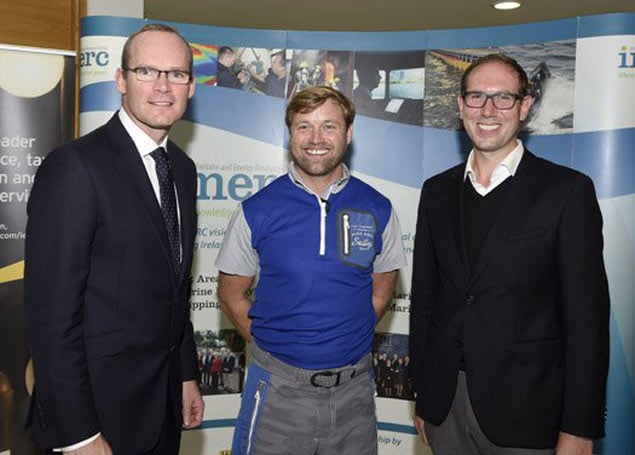 The then Minister for the Marine Simon Coveney, Hugo Boss skipper Alex Thomson, and Stewart Hosford at the announcement in Cork in 2015 of a possible international offshore racing hub on Haulbowline Island.
The then Minister for the Marine Simon Coveney, Hugo Boss skipper Alex Thomson, and Stewart Hosford at the announcement in Cork in 2015 of a possible international offshore racing hub on Haulbowline Island.
In the meantime, the word on the waterfront is that the two skippers may do the two-handed Barcelona World Race 2018 in the current boat. But beyond that, the campaign plan for the charismatic O’Leary, mentored by Thomson and orchestrated by Stewart Hosford, is rumoured to be the building up of enough resources to keep this boat, yet also build a new one.
This is because the boat is still almost state-of-the-art, she has some features still absent in other boats, and could be serious opposition in someone else’s hands. Thus the ideal scenario is to maintain control of their current technology and design, while moving on to the next stage of development with an even more advanced boat for the Vendee Globe in 2020.
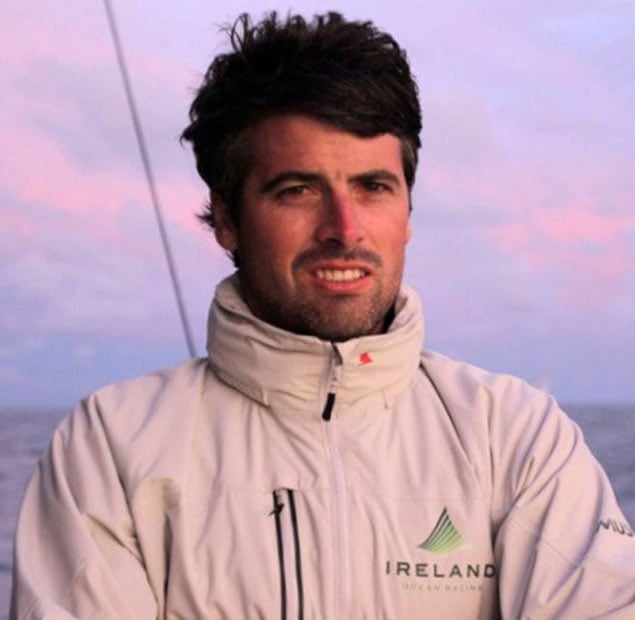 Nin O’Leary – a charismatic figure for Ireland’s younger sailors
Nin O’Leary – a charismatic figure for Ireland’s younger sailors
We’re talking mega-bucks here, and the relationship with Hugo Boss has been very fruitful, but the elephant in the room - which hasn’t been mentioned yet - is how long will the Hugo Boss sponsorship continue?
This may all become clearer within the next ten days, as Thomson, O’Leary and Hugo Boss are headed for Ireland, with Cork in their sights on Monday 28th and Tuesday 29th August, and then they’re in Dun Laoghaire for a very public appearance on Wednesday August 30th, and staying until the Friday, September 1st for the ongoing launch of their new brand Ireland Ocean Racing.
This puts them top of the billboards. But we mustn’t let it blind us to the hopes of other campaigners, and on Thursday of this week, Tom Dolan made his final public appearance in Ireland before returning to France for the countdown towards the start of the Mini Transat 2017 from La Rochelle at the beginning of October.
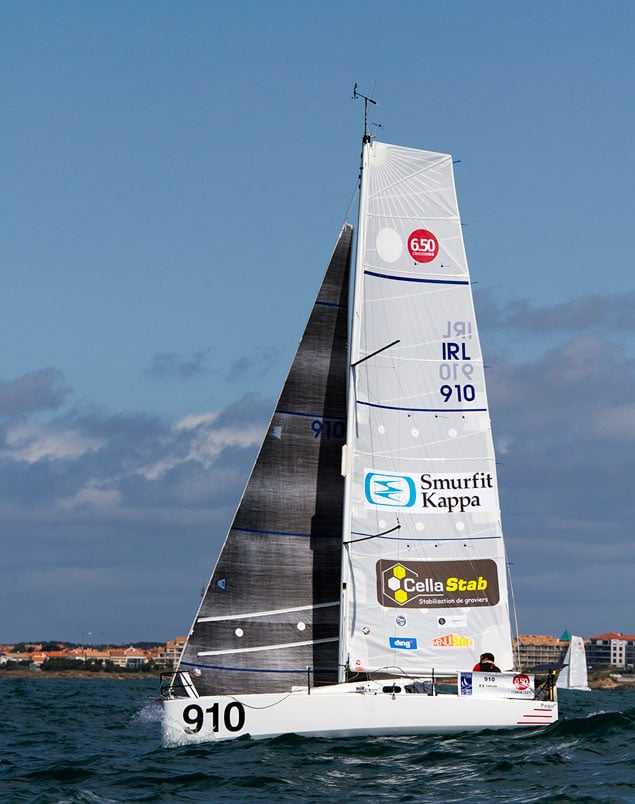 Although Tom Dolan has some sponsorship for IRL 910, there is still a shortfall in funding for the Mini Transat 2017 which starts at the beginning of October from La Rochelle
Although Tom Dolan has some sponsorship for IRL 910, there is still a shortfall in funding for the Mini Transat 2017 which starts at the beginning of October from La Rochelle
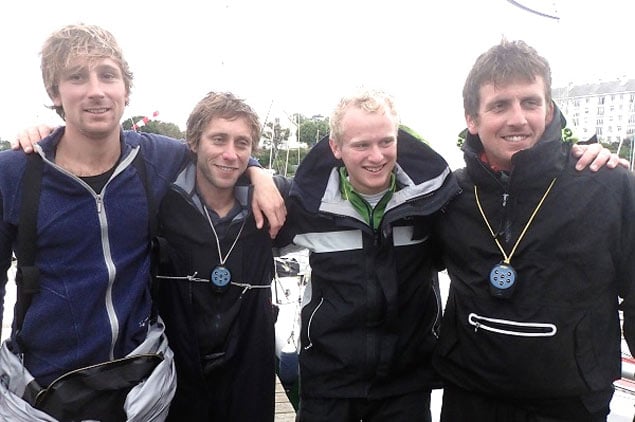 Tom Dolan (right) and fellow skippers in the Mini 650 class at Concarneau. The camaraderie and mutual help among the sailors contributes to France’s dominant position in short-handed sailing
Tom Dolan (right) and fellow skippers in the Mini 650 class at Concarneau. The camaraderie and mutual help among the sailors contributes to France’s dominant position in short-handed sailing
Although Tom has some support backers whose logos appear on his sails, he makes no bones about his overall situation, as his Pogo 3, IRL 910, currently enters races under the name of “Still Seeking a Sponsor”. Whether his presentation in the National YC on Thursday will turn on any money taps in Ireland remains to be seen, the fact is that it’s in France he makes most impact. But in Dun Laoghaire, his burning enthusiasm left an abiding impression, for although his chosen life-path may be more exciting than running the small family farm in Meath, there are times when it’s a massive struggle.
Tom is one of several Irish international offshore wannabees and established skippers who have made a point of having the cup of coffee with Marcus Hutchinson. Hutchinson has transformed himself from being a young sailor who first learned his craft in Howth into an international sailing campaign management figure who maintains his Irish connections through Kinsale, yet is now a key presence at the French-led cutting edge of specialist offshore programmes.
 Marcus Hutchinson is first Port of Call for anyone seriously contemplating a short-handed offshore campaign
Marcus Hutchinson is first Port of Call for anyone seriously contemplating a short-handed offshore campaign
It’s rumoured that in Brittany he has access to a large warehouse full of IMOCA 60s and Open 40s and whatnot. What we do know for sure is that he was very much the background force in Paul Meilhat’s stunning victory in the IMOCA 60 SMA in the recent Rolex Fastnet Race, a neatly-read campaign whose success was highlighted by the inescapable fact that Hugo Boss finished eighth out of the nine IMOCA 60s competing.
SMA with her dagger boards was optimized for windward work, whereas Hugo Boss with her foils most emphatically wasn’t. But while those in the know are aware of this, Joe Public simply sees the final results and takes it from there.
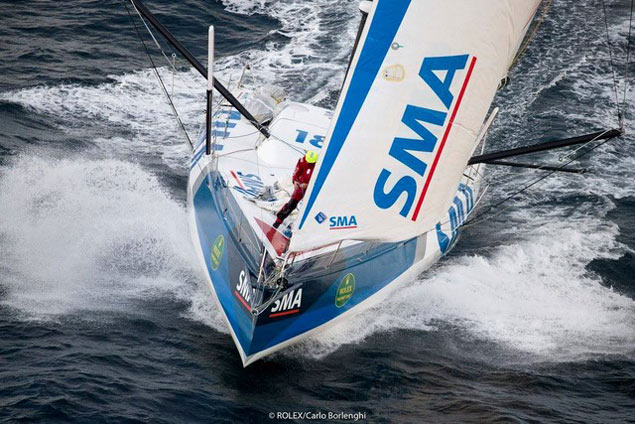 The Marcus Hutchinson-managed SMA was convincing winner of the IMOCA 60 Class in the Rolex Fastnet Race 2017. Photo: Carlo Borlenghi
The Marcus Hutchinson-managed SMA was convincing winner of the IMOCA 60 Class in the Rolex Fastnet Race 2017. Photo: Carlo Borlenghi
Marcus Hutchinson’s deep well of sound advice is available to those who seek him out, and he is generous with his knowledge and sensible thoughts. Talking to Afloat.ie yesterday morning, he made the point that of the current wave of French superstars in the bigger boats, many have done the Figaro Solo at least a dozen times, and he reckons that setting out to take on the Vendee Globe straight from a career – however successful – in fully-crewed boats, is akin to taking on Everest solo without first trying a few smaller mountains on your own.
The list of those specialist sailors from Ireland who have made a point of seeking advice and assistance at some stage from Marcus Hutchinson is both impressive and fascinating, as it includes Damian Foxall, Justin Slattery, Enda O'Coineen, David Kenefick, Joan Mulloy, Sean McCarter, Tom Dolan and most recently Conor Fogerty.
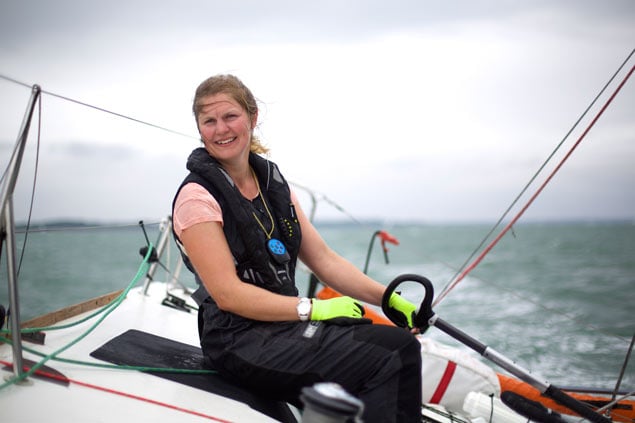 Joan Mulloy of Westport in County Mayo has secured a Figaro through Marcus Hutchinson, but still requires sponsorship
Joan Mulloy of Westport in County Mayo has secured a Figaro through Marcus Hutchinson, but still requires sponsorship
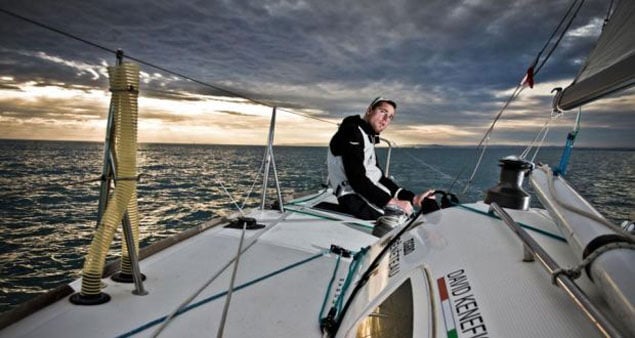 David Kenefick of Cork is another solo sailor who was guided into the Figaro Class by Marcus Hutchinson
David Kenefick of Cork is another solo sailor who was guided into the Figaro Class by Marcus Hutchinson
And a salient fact which emerges in talking to some of them is the thought that while the Alex Thomson/Hugo Boss campaign was impressive, its central ethos of being stand-alone was ultimately counter-productive.
Two of the lone skippers mentioned above went so far as to say that if the Hugo Boss campaign had been prepared to mix it a bit more with the strongholds of French single-handed sailing in Brittany, then they would have won the Vendee Globe instead of coming second.
That’s undoutedly one for the speculation mill. But it gets a certain reinforcement from a statement this week from Nin O’Leary, to the effect that moving the base from Portsmouth to Cork would have the beneficial result of making the major French centres seem more accessible, as there’s almost a feeling of being trapped in the Eastern Solent, whereas in Cork it’s open water – and open thinking - all the way to Ushant and beyond.
This desire for open water and open thinking is spreading. One of the most interesting news items of recent weeks was that Olympic Silver Medallist Annalise Murphy hoped to secure a berth aboard Dee Caffari’s Volvo 65 for the up-coming Volvo World Race. Unfortunately the knee injury Murphy exacerbated with a spectacular capsize at the conclusion of becoming the International Moth Women’s World Champion 2017 on Lake Garda has put that idea on hold, but this shift of interest from the grind of Olympic training on a tedious four year cycle to the more stimulating world of big-time offshore stuff, with maior events coming up in rapid succession, reflects a discernible pattern of changing public awareness.
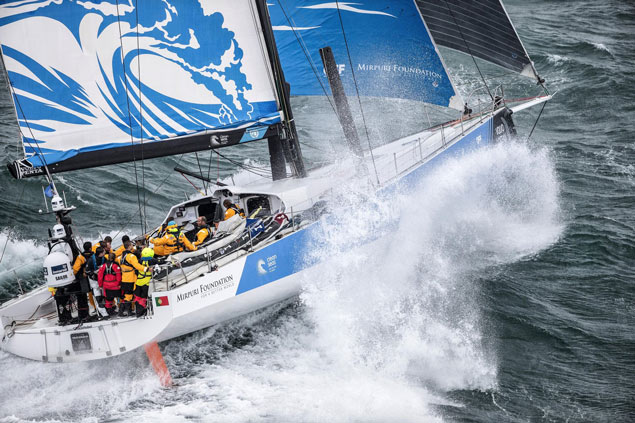 The new Volvo 65 Turn the Tide on Plastic. Olympic Silver Medallist Annalise Murphy had to defer taking up a berth on Dee Caffari’s Volvo 65 because of a knee injury sustained during a capsize in the Moth Worlds at Lake Garda
The new Volvo 65 Turn the Tide on Plastic. Olympic Silver Medallist Annalise Murphy had to defer taking up a berth on Dee Caffari’s Volvo 65 because of a knee injury sustained during a capsize in the Moth Worlds at Lake Garda
So Olympic sailing, ever mindful of the need to continue to attract public attention by whatever means, is going to include a test offshore series, probably for two person boats, in the Tokyo Olympics in 2020.
This is of particular interest to any Irish sailor desperately seeking sponsorship, for the reality is that on our island, there are only half a dozen sports – if that - which are big enough to make an impact on their own. The minority sports - sailing included - only figure significantly in public awareness if they come up in the Olympic searchlight.
That Olympic searchlight in turn encourages others to get involved, thereby stretching the cloak of sponsorship ever thinner. So it will be some time, if ever, before we see a joint approach to the challenge of raising sponsorship for this branch of sailing. And Heaven knows, but it’s difficult enough to get an effective short-handed sailing campaign of international standard up to speed without the endless worry of finding the money. Yet that’s the way it is. But if you really do find the challenge irresistible, Afloat.ie’s advice is to make arrangements to have a cup of coffee with Marcus Hutchinson before you do anything else.
Royal Cork David Kenefick's Fastnet Race ambitions lie in ruins this evening after a dismasting on his class 40 entry. It's a disappointing outcome because Kenefick was in the mix in the top five of the ultra competitive Class 40 fleet. 'We lost are mast due to gear failure, Kenefick told Afloat.ie
It's a shock for the Cork Harbour helmsman who last week posted the top Irish result at the Moth Worlds, as Afloat.ie reported here.
'We managed to get the mast back on to the boat and headed into Weymouth, Kenefick told Afloat.ie
A fine turnout of Irish Moth sailors were rewared yesterday with three gold fleet finishes at the high–calibre 220–boat Moth World Championshis on Lake Garda, Italy. Royal Cork's David Kenefick was top Irish with a 31st in the Gold fleet sailing his brand new boat (as Afloat.ie reported previously here). Kenefick was just one point outside the top thirty. 'I'm quite happy with that, lots to work on before the next worlds in may in Bermuda', the RCYC sailor told Afloat.ie.
Next was Irish Moth Champion Rory Fitzpatrick, sailing a County Wicklow design in 35th, the Dubliner was unfortunately forced out of the regatta early after a collision. Olympic Laser Radial Silver Medalist Annalise Murphy was top female in 51st place.
Among other Irish results, Howth Yacht Club's stand–out youth performer Ewan McMahon had a 23rd and two behind him was the National Yacht Club's Neil O'Toole in 25th. Howth Yacht Club's Alistair Kissane was 56th and Royal St. George Yacht Club's Adam Hyland was 73rd. Another Royal St. George Yacht Club sailor Jim Devlin was a bronze fleet finisher.
Download the official results below at the bottom of this story.
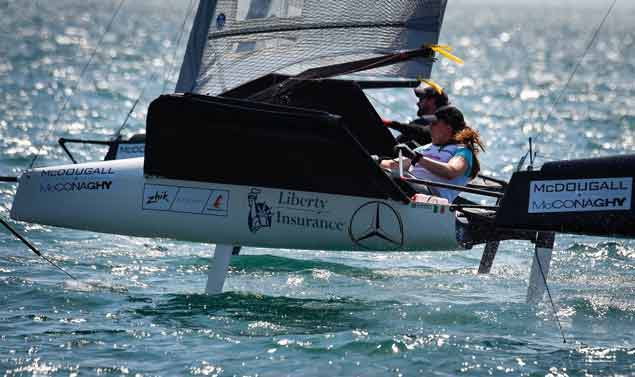 Annalise Murphy sailed one day with a broken rudder and capsized 'about 50 times'. 'I knew something was wrong but didn't know what! I was actually pretty lucky it didn't completely break off and sink!, the Olympic Silver Medalist told Afloat.ie. Photo: Martina Orsini
Annalise Murphy sailed one day with a broken rudder and capsized 'about 50 times'. 'I knew something was wrong but didn't know what! I was actually pretty lucky it didn't completely break off and sink!, the Olympic Silver Medalist told Afloat.ie. Photo: Martina Orsini
Paul Goodison (GBR) smashed it on the final day of racing at the 2017 McDougall + McConaghy Moth Worlds at Lake Garda against the hottest fleet of Moths ever assembled. Goody (to his friends), is the first foiling Moth sailor to win back to back world titles and the result is that much more special considering the high calibre of competition from the most recent top Americas Cup skippers and sailors with more Olympic medals round their necks than any other regatta with exception of the Olympic Games itself!
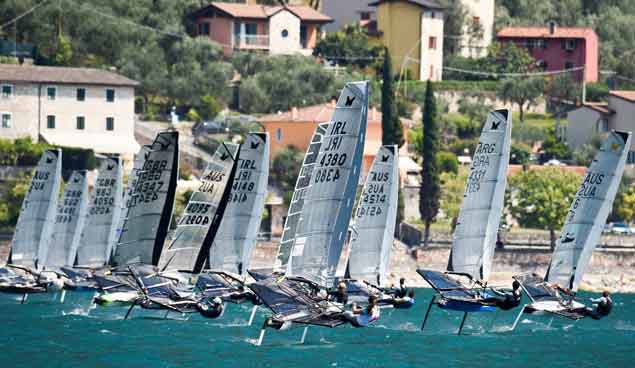 Part of the massive 220–boat Moth Worlds on Lake Garda – the largest fleet ever assembled. Photo: Martina Orsini
Part of the massive 220–boat Moth Worlds on Lake Garda – the largest fleet ever assembled. Photo: Martina Orsini
Going into the final day of racing Goodison begun the day with a 13 point cushion over Pete Burling (NZL) with Iain ‘Goobs’ Jensen with an outside chance of catching Burling.
The weather gods turned it on again for the final day of racing when a light ‘Ora’ started to build from the South around lunchtime and any fluffy little clouds dispersed to leave another fine sunny afternoon for racing.
The Gold fleet was sent out around 1330hrs to race on the South course to complete as many races as possible before the cut off time of 1600hrs. Race 9 of the championship started under the black flag in 12 – 14 knots of breeze with flat water. As usual, the aim was to charge to the Eastern shore and before hitting the rocks in front of the Fraglia Vela Malcesine clubhouse, tack and try to find a clean lane of pressure to get to the top of the course in good shape.
At the windward gates, the breeze was quite soft causing a number of boats to drop off the foils, especially if squeezing round the marks. On the first lap it was Scott Babbage (AUS) leading, followed by the young gun, Gian Ferrighi (ITA) with most of the big names in the top 10. The downwind leg proved a bit more shifty and the pack shuffled. It was Tom Slingsby (AUS) who stayed in the best pressure to take the win from Nathan Outteridge (AUS) with Rob Greenhalgh (GBR) third, Burling 5th and Jensen 6th.
PRO Tim Hancock did a good job of setting up for race 10 under the same conditions. Started under a black flag it was a similar story with slightly different players. The breeze shifted a bit right and begun to drop at the top end causing some competitors to drop off the foils.
At the bottom gate, the action started to unfold, Jensen got round just in front of Slingsby but Slingers dropped off the foils bang in front of Outteridge and Babbage allowing Goodison to slide past inside avoiding the low riders. Burling was also in trouble rounding the opposite gate and dropping off the foils. Greenhalgh was also in a world of pain.
Coming into the finish it was Jensen who crossed the line with a massive lead and a big smile on his face as he closed up the points to second placed Burling to one point. Second was Goodison to all but seal the title. Many competitors had fallen off the foils in the soft patches around the course. Singsby crossed third but Burling was deep in the pack.
With time running out and the breeze getting a bit weak, the PRO announced that the third race of the day, race 11 of the world championship would be the last. The last race would be victory laps for Paul Goodison but the chase for second and third would be decided on the last race between Burling and Jensen.
The last race started in the same light to moderate breeze, 11 – 13 knots from 215 degrees. Again the fleet used the clubhouse shoreline for a flyby in front of the grandstand of supporters. This time it was Tom Slingsby who looked like he had made the right foil choice leading the world champion elect with some of the usual suspects struggling with foil selection. Slingsby cruised across the finish line for a second win of the day with the victorious Goodison crossing in second.
A good third for West Australian, Steve Thomas, Babbage finished a consistent 4th and Jensen in 5th finishing comfortably ahead of his skipper of so many years, Nathan Outteridge. As Burling crossed in a lowly 17th, supporters scrambled for their calculators to do the maths.
Agonisingly for Goobs Jensen he fell one point short of toppling the kiwi but was very happy with his third place overall. With Slingsby’s final day score of 1,3,1 he held on to 4th and Scott Babbage came back from the brink early in the regatta to snatch 5th off Nathan Outteridge.
The Youth category went down to the wire on the final day with a fine battle between the two Italian twins Gian Marie and Stefano Ferrighi. With an 8th in the final race on Saturday and a 9th today (Sunday), Stefano stole the title from his brother by 3 places. Stefano finished 23rd overall an excellent performance in a fleet of champions.
The Master’s category swung between Jason Belben (GBR) and Rob Gough (AUS) and a similar tussle played out. Rob Gough won this one finishing 25th overall to Jason Belben’s 28th.
First in the female category went to Irish Olympian Annalise Murphy who finished 51 in the Gold group.
The Silver group was won by John Clifton (GBR) and the Bronze group won by Maximilian Mage of Germany.
PRO Tim Hancock and his team did a great job getting through so many races for a fleet of 220 Moths, the biggest Moth regatta ever assembled.
Royal Cork's David Kenefick has just finished foiling week on Italy's Lake Garda sailing his Full Irish Moth. Kenefick is keeping an eye on the Italian venue given it will host next year's World Championships in 2017 where a fleet of 200 is expected.
The Crosshaven sailor finished 19th out of 43 which is something of a comeback after breaking his rig at the Europeans and missed two days racing earlier this month in France.
'I'm happy as I've only being racing the Moth a few months, with this being my first full regatta', Kenefick told Afloat.ie
'I've a few improvements to make to the boat including a bow sprit and a new foil', he added.
Kenefick Moves to Moth Dinghy at Royal Cork
Former Figaro keelboat campaigner David Kenefick from Royal Cork Yacht Club is back on the water (or is that above the water?) in Cork Harbour. Kenefick is the latest sailor to move to the foiling Moth dinghy that is centred at the National Yacht Club in Dun Laoghaire.




























